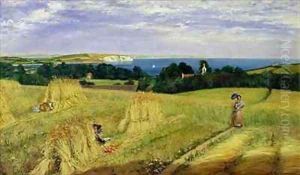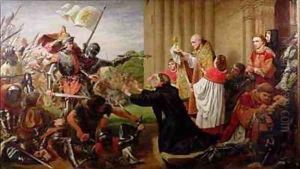Richard Burchett Paintings
Richard Burchett was a significant figure in 19th-century British art, particularly known for his contributions as an artist, educator, and arts administrator. Born in Brighton, England, in 1815, he pursued his artistic education at the Royal Academy Schools, where he studied under the likes of Henry Fuseli and later served as Keeper.
Burchett's early work encompassed historical and genre painting, but he is perhaps best remembered for his role in the education sector. In 1843, he became involved with the Government School of Design, which later became the Royal College of Art. His influence was felt through his teaching and administrative roles, where he advocated for the importance of art education and the integration of design into British industry, which was particularly pertinent during the period of the Industrial Revolution.
As an artist, Burchett was known for his frescoes and mural works, many of which adorned public buildings of the era. His artistic style was rooted in the traditions of the Pre-Raphaelite Brotherhood, a movement that sought to bring a sense of realism and attention to detail to art, in contrast to the more formulaic approaches that dominated the early Victorian period.
Burchett's career also involved significant work with the South Kensington Museum, now known as the Victoria and Albert Museum. He played a key role in the acquisition and organization of the museum's early collections, setting a foundation for what would become one of the world's most renowned institutions for decorative arts and design.
Despite his contributions, Burchett's name is not as widely recognized as some of his contemporaries. He passed away in 1875, leaving behind a legacy that would influence British art education for generations. His commitment to the integration of practical design and art into education remains a cornerstone of art and design instruction to this day.

